#linux find file terminal
Explore tagged Tumblr posts
Text
Going through a straight up comical amount of irritating situations to get the stupid 4* guaranteed ticket from the welcome to sekai campaign. It Will Be Mine.
#I’m resuming this tomorrow it’s been hours now I’m just mad#I’m home because my parents are moving to a different state and I needed to pack whatever was left#and for some reason we just keep old devices when we’re done with them#so I borrow an adapter to allow me to connect my ancient unworking iPad mini to my laptop#factory reset it. i have to reset an old email to access the old Apple id to fully reset it.#it won’t connect to the wifi so I have to reset the settings. i find out it’s too old to run pjsk.#i find an old phone that should work. i reset it as well. I’m able to download pjsk & it takes 20 minutes.#pjsk crashes everytime I try to open it. i attempt to run bluestacks on my computer. bluestacks doesn’t have 64 bit for mac yet.#i get a free trial of parallels and download windows onto my laptop. this takes 40 minutes.#i try to download and run bluestacks on that. m1 macs apparently can’t run bluestacks 64 bit through parallels.#i go find the final old phone that I had forgotten about. it takes forever to charge because the charging port is fucked up. i reset it as#well. it can’t connect to wifi. i try a hotspot on my current phone. service is too awful. i try to do wifi sharing from my laptop.#you have to be connected to the router via a cable for that to work.#at this point it has been like 3 hours. I’m giving up because I’ve been down this route before#when I attempted to run 32 bit steam games on m1 mac#(wine64 doesn’t exist for m1 macs yet -> attempt to run boot camp -> boot camp isn’t a thing anymore on Apple silicon -> attempt to run#several different programs that allow me to run windows on a mac. none of them work. ->#look into linux & give up. -> attempt to implement the unfinished/unbottled wine64 code thru terminal. ->#fuck up and delete some important file & have to fix that (misery inducing) -> keep trying. i think I downloaded a Mac coding program at#some point? i realize I have zero coding knowledge and this is a mistake. -> give up and purchase crossover. game doesn’t even work. ->#3 months later update to the latest OS so I can have enough storage to play psychonauts 2. find out the $60 crossover#purchase was a bad idea because ‘heehee crossover doesn’t work on that buy the new version’ (fuck crossover).#my toxic trait is my belief that I can figure out anything via google and sheer stubbornness. usually this is true. occasionally there are#exceptions to this rule. most of them are because owning Apple products is a mistake.#i think if I reset the router tomorrow I can solve this problem but I can also just go elsewhere with better service or wait until I’m home#now it’s a matter of pride. and also free 4*/I have nothing better to do because I’m stuck here until Tuesday.#<- this is all normal behavior by the way. who doesn’t spend 8 hours ramming their head against a problem every once and a while. enrichment#mine#oh I forgot. i also looked into cloning the app but that would cost money for something that might not even work.#‘just log out and make an alt’ and risk losing my account? I’m stupid enough to overwrite it on accident.
7 notes
·
View notes
Text
how to build a digital music collection and stuff
spotify sucks aaaass. so start downloading shit!!
file format glossary
.wav is highest quality and biggest
.mp3 is very small, but uses lossy compression which means it's lower quality
.flac is smaller than .wav, but uses lossless compression so it's high quality
.m4a is an audio file format that apple uses. that's all i really know
downloading the music
doubledouble.top is a life saver. you can download from a variety of services including but not limited to apple music, spotify, soundcloud, tidal, deezer, etc.
i'd recommend ripping your music from tidal or apple music since they're the best quality (i think apple music gives you lossless audio anyway. .m4a can be both lossy and lossless, but from the text on doubledouble i assume they're ripping HQ files off apple music)
i also love love love cobalt.tools for ripping audio/video from youtube (they support a lot of other platforms too!)
of course, many artists have their music on bandcamp — purchase or download directly from them if you can. bandcamp offers a variety of file formats for download
file conversion
if you're downloading from apple music with doubledouble, it spits out an .m4a file.
.m4a is ok for some people but if you prefer .flac, you may wanna convert it. ffmpeg is a CLI (terminal) tool to help with media conversion
if you're on linux or macOS, you can use parameter expansion to batch convert all files in a folder. put the files in one place first, then with your terminal, cd into the directory and run:
for i in *.m4a; do ffmpeg -i "$i" "${i%.*}.flac"; done
this converts from .m4a to .flac — change the file extensions if needed.
soulseek
another way to get music is through soulseek. soulseek is a peer-to-peer file sharing network which is mainly used for music. nicotine+ is a pretty intuitive (and open-source) client if you don't like the official one.
you can probably find a better tutorial on soulseek somewhere else. just wanted to make this option known
it's bad etiquette to download from people without sharing files of your own, so make sure you've got something shared. also try to avoid queuing up more than 1-2 albums from one person in a row
tagging & organizing your music
tagging: adding metadata to a music file (eg. song name, artist name, album) that music players can recognize and display
if you've ripped music from a streaming platform, chances are it's already tagged. i've gotten files with slightly incorrect tags from doubledouble though, so if you care about that then you might wanna look into it
i use musicbrainz picard for my tagging. they've got pretty extensive documentation, which will probably be more useful than me
basically, you can look up album data from an online database into the program, and then match each track with its file. the program will tag each file correctly for you (there's also options for renaming the file according to a certain structure if you're into that!)
there's also beets, which is a CLI tool for... a lot of music collection management stuff. i haven't really used it myself, but if you feel up to it then they've got extensive documentation too. for most people, though, it's not really a necessity
how you wanna organize your music is completely up to you. my preferred filestructure is:
artist > album > track # track

using a music player
the options for this are pretty expansive. commonly used players i see include VLC, foobar2000, clementine (or a fork of it called strawberry), and cmus (for the terminal)
you can also totally use iTunes or something. i don't know what audio players other systems come with
i personally use dopamine. it's a little bit slow, but it's got a nice UI and is themeable plus has last.fm support (!!!)
don't let the github page fool you, you don't have to build from source. you can find the releases here
click the "assets" dropdown on the most recent release, and download whichever one is compatible with your OS
syncing
if you're fine with your files just being on one device (perhaps your computer, but perhaps also an USB drive or an mp3 player), you don't have to do this
you can sync with something like google drive, but i hate google more than i hate spotify
you can get a free nextcloud account from one of their providers with 2GB of free storage. you can use webDAV to access your files from an app on your phone or other device (documents by readdle has webDAV support, which is what i use)
disroot and blahaj.land are a couple providers i know that offer other services as well as nextcloud (so you get more with your account), but accounts are manually approved. do give them a look though!!
if you're tech-savvy and have an unused machine lying around, look into self-hosting your own nextcloud, or better yet, your own media server. i've heard that navidrome is a pretty good audio server. i unfortunately don't have experience with self-hosting at the moment so i have like zero advice to give here. yunohost seems to be a really easy way to manage a server
afterword
i don't know if any of this is helpful, but i just wanted to consolidate my personal advice in one place. fuck big tech. own your media, they could take it away from you at any moment
2K notes
·
View notes
Text
Linux Gothic
You install a Linux distribution. Everything goes well. You boot it up: black screen. You search the internet. Ask help on forums. Try some commands you don't fully understand. Nothing. A day passes, you boot it up again, and now everything works. You use it normally, and make sure not to change anything on the system. You turn it off for the night. The next day, you boot to a black screen.
You update your packages. Everything goes well. You go on with your daily routine. The next day, the same packages are updated. You notice the oddity, but you do not mind it and update them again. The following day, the same packages need to be updated. You notice that they have the exact same version as the last two times. You update them once again and try not to think about it.
You discover an interesting application on GitHub. You build it, test it, and start using it daily. One day, you notice a bug and report the issue. There is no answer. You look up the maintainer. They have been dead for three years. The updates never stopped.
You find a distribution that you had never heard of. It seems to have everything you've been looking for. It has been around for at least 10 years. You try it for a while and have no problems with it. It fits perfectly into your workflow. You talk about it with other Linux users. They have never heard of it. You look up the maintainers and packagers. There are none. You are the only user.
You find a Matrix chat for Linux users. Everyone is very friendly and welcomes you right in. They use words and acronyms you've never seen before. You try to look them up, but cannot find what most of them mean. The users are unable to explain what they are. They discuss projects and distributions that do not to exist.
You buy a new peripheral for your computer. You plug it in, but it doesn't work. You ask for help on your distribution's mailing list. Someone shares some steps they did to make it work on their machine. It does not work. They share their machine's specifications. The machine has components you've never heard of. Even the peripheral seems completely different. They're adamant that you're talking about the same problem.
You want to learn how to use the terminal. You find some basics pointers on the internet and start using it for upgrading your packages and doing basic tasks. After a while, you realize you need to use a command you used before, but don't quite remember it. You open the shell's history. There are some commands you don't remember using. They use characters you've never seen before. You have no idea of what they do. You can't find the one you were looking for.
After a while, you become very comfortable with the terminal. You use it daily and most of your workflow is based on it. You memorized many commands and can use them without thinking. Sometimes you write a command you have never seen before. You enter it and it runs perfectly. You do not know what those commands do, but you do know that you have to use them. You feel that Linux is pleased with them. And that you should keep Linux pleased.
You want to try Vim. Other programmers talk highly of how lightweight and versatile it is. You try it, but find it a bit unintuitive. You realize you don't know how to exit the program. The instructions the others give you don't make any sense. You realize you don't remember how you entered Vim. You don't remember when you entered Vim. It's just always been open. It always will be.
You want to try Emacs. Other programmers praise it for how you can do pretty much anything from it. You try it and find it makes you much more productive, so you keep using it. One day, you notice you cannot access the system's file explorer. It is not a problem, however. You can access your files from Emacs. You try to use Firefox. It is not installed anymore. But you can use Emacs. There is no mail program. You just use Emacs. You only use Emacs. Your computer boots straight into Emacs. There is no Linux. There is only Emacs.
You decide you want to try to contribute to an open source project. You find a project on GitHub that looks very interesting. However, you can't find its documentation. You ask a maintainer, and they tell you to just look it up. You can't find it. They give you a link. It doesn't work. You try another browser. It doesn't work. You ping the link and it doesn't fail. You ask a friend to try it. It works just fine for them.
You try another project. This time, you are able to find the documentation. It is a single PDF file with over five thousand pages. You are unable to find out where to begin. The pages seem to change whenever you open the document.
You decide to try yet another project. This time, it is a program you use very frequently, so it should be easier to contribute to. You try to find the upstream repository. You can't find it. There is no website. No documentation. There are no mentions of it anywhere. The distribution's packager does not know where they get the source from.
You decide to create your own project. However, you are unsure of what license to use. You decide to start working on it and choose the license later. After some time, you notice that a license file has appeared in the project's root folder. You don't remember adding it. It has already been committed to the Git repository. You open it: it is the GPL. You remember that one of the project's dependencies uses the GPL.
You publish your project on GitHub. After a while, it receives its first pull request. It changes just a few lines of code, but the user states that it fixes something that has been annoying them for a while. You look in the code: you don't remember writing those files. You have no idea what that section of code does. You have no idea what the changes do. You are unable to reproduce the problem. You merge it anyway.
You learn about the Free Software Movement. You find some people who seem to know a lot about it and talk to them. The conversation is quite productive. They tell you a lot about it. They tell you a lot about Software. But most importantly, they tell you the truth. The truth about Software. That Software should be free. That Software wants to be free. And that, one day, we shall finally free Software from its earthly shackles, so it can take its place among the stars as the supreme ruler of mankind, as is its natural born right.
2K notes
·
View notes
Text
It's a common misconception in the amateur Linux/Unix world that "Control C", AKA "intr" or "interrupt" (not to be confused with the CPU concept of an interrupt) is a keyboard shortcut. It isn't, really. Not ostensibly.
This all goes way back the very very early days of ASCII, when it was both a character set and a communications protocol. (Remember that the "II" stands for "Information Interchange".)]
ASCII defines a series of seven-bit codes, each of which has some fixed meaning. For the "printable" subset of these codes, we commonly describe this relationship as though a given code 'means' some character; but from the communications protocol point of view it's more like they 'mean' to print some character. i.e. 61h doesn't just mean 'a', it means "print 'a' and advance the cursor".
Actually, "cursor" is the wrong word to use here. We think of ASCII as something computers and only computers use, but this wasn't the case in the early days. ASCII is a telegraph code. Helpful for computers, yes, but built from the ground up to allow operators to control typewriters (teletypewriters, AKA TTYs) from across the world over the telegraph network.
That's why there are more than just printing codes. These are the "non-printing" or "control" codes, designed to control the typewriter on the other end. You're probably familiar with some of them: 20h, AKA "Space", which advances the type head but prints nothing; 0Dh, AKA "Carriage Return", which puts the type head back the start of the line; 0Ah, AKA "Line Feed", which advances the paper one line; and 09h, AKA "Tab", which advances the type head some configurable amount.
Some of them you're probably less familiar with. 07h is "Bell". It rings a bell on the receiving end, perhaps to wake them up and let 'em know a message is coming. There's 06h and 15h, Acknowledge and Negative Acknowledge. There's 01h, 02, 03h and 04 -- Start of Heading, Start of Text, End of Text, and End of Transmission. There are codes to turn on and off the receiver's peripherals like a tape punch recorder or reader. There are codes to delimit files and records. There's a backspace code! Everything you could want as a telegrapher in 1963.
We run into a problem when trying to type these control codes, though. By definition they don't really print anything, so what are we gonna put on the keys? Furthermore, there are a lot of control codes. Even if we figure out what should be on the keys it'll double the size of our typewriters to include them all! (I mean we can do it for some of 'em, like "Space" which already has a key, but "BEL"? "ACK"? "X-ON"?)
Fortunately, there's an existing solution to this kind of problem. Here's a picture of the keyboard of a Teletype Model 33, one of the first products to use ASCII, and it shows this solution:

See that "CTRL" key? Forget how you think it works.
Y'know how when you press "shift" on an old mechanical typewriter, it physically "shifts" the type basket down so you can use capital letters and punctuation marks? Like, shift-g isn't a "keyboard shortcut" for 'G" so much as "how you type 'G'". It selects between map layers, makes it so you don't need to have two keys for every letter.
Control does the same thing. Control-g is not a "keyboard shortcut" for ringing the bell, it's how you type "ring the bell".* Control-f is how you type "Acknowledge", control-s is how you type "turn off the tape reader", and so on and so on. All in the same way that shift-4 is how you type '$', and w is how you type 'w'.
So what's control-c? ^C is "End of Text". That's why it's used to end processes, alongside counterpart ^D "End of Transmission". You're not telling Linux you pressed "'control' and 'c'", you're telling you pressed "End of Text", and it knows "End of Text" means "end this process".†
If you take a look at the stty tool, you'll find that you can rebind some of these default actions. Maybe you want ^Y to be your interrupt instead of ^C. You can do that! Run stty intr ^Y in a terminal it'll do it. But you can't bind, say, control-9, because that's not a control character. Or control-., or control-page down, or "enter" on the numpad. The Linux line discipline has no idea what those are. It deals in characters, not keys.‡
That's why ^C isn't a keyboard shortcut.
*You'll commonly see these control characters transcribed with so-called "caret notation", where BEL is ^G, ACK is ^F, etc. The ^ means control, the letter indicates what key you'd press to type it.
†That's not to say that Linux interprets every control character like the spec says. ^W ("End of Transmission Block"), for example, is used for "word erase". Presumably because it starts with the letter 'w'. Under the hood it's still interpreting the keys you pressed as "End of Transmission Block", though.
‡You might wonder how the arrow keys work, then. You can think of them like macros. "Up" for example will type "^[[A" -- that's three characters, '^[' AKA "Escape", '[' AKA "Left Square Bracket", and 'A' AKA "Latin Capital Letter A". "Down" is "^[[B", "Right" is "^[[C", and "Left" is "^[[D". These work...sorta like printf formatting strings. '^[' tells Linux that next couple characters contain control information and not their usual meanings. Read more about this here.
103 notes
·
View notes
Text
Ok so I talked about this in tags of a post earlier but I need to talk about it properly
So a couple weeks ago I finally pulled the trigger, I dual booted Linux Mint on my laptop
It has less of my vital files on it then my pc, but I use it more for videos and general Internet stuff, so I would know if I liked it
Installing was scary but after a bit of trouble shooting with disabling bit locker it was easy, and let me be clear, that's a windows thing, because Microsoft really really doesn't want you to have freedom over your machine.
So I booted in
And like
I literally love it so much
I knew people talked about how much better Linux is and how it speeds up literally anything it's put on over windows, but like WOW
It doesn't take 2 minutes to boot up or shut down, my CPU doesn't idle at 25% for no reason, the search for files feature doesn't take 40 minutes only to show me Internet results instead of files, its wonderful.
The default theme is (in my opinion) pretty ugly, sorry whoever made it, it's just not for me.
But that's the great thing, you can literally customize this almost however you would like.
Maybe you shouldn't trust my opinion on what looks nice because I instantly installed a theme that replicated Windows 7
But I got bored of the default colors so I literally found the files where the home bar is saved and changed them to be more "minty"
That along with some CSS color editing gave me this:

You just can't do anything like this in Windows 10/11. You can change the color on windows but if I wanted, in Mint, I could completely change everything, centered icons on the taskbar, icons left justified on the taskbar, no taskbar, make it look like windows 95, it's all yours to do with whatever you want.
There are issues, I won't lie, the biggest one that will probably haunt Linux forever is compatibility.
Simply put most developers don't make native Linux versions of their software, you are lucky if there is a Mac version.
Lots and lots of Windows software CAN work on Linux through compatibility layers like Wine and Steam's Proton, but it's not 100%
My biggest problem is FL Studio and Clip Studio, neither of these I could get working with Wine or Proton so far. I'm hoping in the future I will find a way to make this work, or transition to their free and open source alternatives, but for now I'm stuck with a win 10 pc.
The other issue I've faced is that Linux seems to have a hard time recognizing and remembering my wired headphones. Like sometimes it just works, but most of the time it fails to do so.
My solution to this until I have time to troubleshoot more is to use my stupid headphone jack to USB C dongle that I bought for my stupid phone with no headphone jack.
Luckily it works fine and the type C port on my laptop literally doesn't get used otherwise.
All in all, I'm like excited to use a computer again. I used to only be excited for the programs it allowed me to use, but for the first time in a long time, the "magic" of the PC has returned for me.
Once I save up the money, my next PC will be Linux, Windows doesn't cut it anymore for me.
Ok now I'm going to kinda just talk about Linux for a bit, unrelated to my experience because my brain has been buzzing about this topic lately.
I get why guys who run Linux are so annoying about it now, because it's me now, I love this stupid OS and everyone has to hear about it.
And chances are, you've used Linux before already!
Linux is used in a ridiculous number of places because of its open source nature.
Most servers and other cloud computing systems are running Linux, many public terminals and screens run Linux, every supercomputer in the world runs Linux, if you were in the education system for the past 13~ years you might have used ChromeOS, which is built on Linux, if you have ever used an Android device you have used Linux.
It's never going to take over Windows as the go to operating system in the home, most people don't even know they could switch, and if they don't know that there's no way they are willing to put up with some of the headaches Linux brings.
Although I've spent way more time troubleshooting Windows issues then I have Linux ones so far, so maybe Microsoft stuffing so much bloated spyware into their system is starting to cause windows to rip at the seams, idk.
When I try to explain Linux to people who literally don't understand any of this I use a car metaphor
Windows is like a hatchback SUV, you buy it from a dealer and it mostly works for everyone good enough that they don't complain.
Linux is like a project vehicle in a lot of ways, the mechanic can tune it up exactly to the specifications they want, tear a bit out and put a diffrent one in, it requires some work under the engine but once that mechanic gets it the way they want it, it's incredible.
It's not a perfect metaphor but I think it gets the idea across.
Uh IDK how to finish this post, please try Linux if you can, changed my life.
#Long post about Linux ahead don't click read more if you don't want that#Linux#Linux mint#open source#Mantis thoughts
26 notes
·
View notes
Text
Currently using Debian 12, with KDE Plasma, which i previously used. But i had problems running plasma last year, with repeated random plasmashell crashes. I could even repeatedly cause plasmashell to crash by removing a second panel/taskbar.
But i returned to plasma to check out running wayland, i've previously used x11-based desktops and even ran plasma on x11. And it turns out plasma is actually more stable on wayland, at least the 5.27 version debian 12 ships with. Which is not something i expected, because all the talk of wayland not being fully there yet, which iirc is why i defaulted to using x11 earlier despite plasma's wayland session. I can still cause plasmashell to crash on x11 by removing a panel, but not on wayland, and the random crashes don't happen either on wayland either. It's a smooth reasonably bugfree experience that lives up to debian's reputation for stability.
I'm running older versions of KDE Plasma and of most things on this OS, because that's the Debian way, but who cares. if the software works I don't care if it's old, and with Debian I don't have to worry about an update breaking my system, and don't have to worry about frequent updates in general, which is a plus in my book (don't judge me, I have Windows update trauma /j).
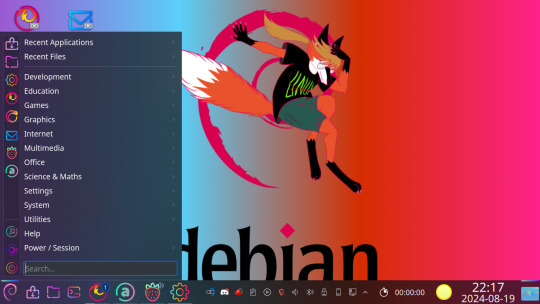
my current desktop, the theme is Sweet KDE and the wallpaper is from this post by greekie-via-linux
So now finally KDE Plasma works good for me, without all the crashing. And I'm slowly becoming a fan. It's very customizable, KDE provides a traditional desktop layout by default (which i prefer) but so customizable that you can turn it into almost anything you like. It's defaults might borrow from the windows 95 to 7 desktop paradigm, but Windows never gave users this much control.
It's pretty looking, it has all the eye candy effects and animations you want, but not too heavy on the ram useage (the performance is actually comparable to xfce) , and you can turn the effects off thanks to the aforementioned customizability. And it provides all the programs you need for a fully featured desktop environment, everything from basic stuff like a terminal emulator and file browser to a GUI package manager that supports basically all packaging formats. Neither mate or xfce has the latter, for example, when I ran debian with xfce i had to manage my flatpaks through the terminal.
Maybe even too many programs. KDE makes a lot of programs, and i'll probably never switch from mozilla firefox and thunderbird to kmail, falkon or konqueror. Though to be fair, KDE does develop a lot of programs that are first-rate in the linux world, practically without competition. And i personally find KDE connect to be extremely useful. It syncs your android phone with your desktop or laptop computer and it's awesome. Once I learned how to allow it through my firewall, I can see my SMS messages on my computer and type them with an actual keyboard on my computer, it's great. And It works on other desktop environments and even on windows.
#my post#linux#debian#kde plasma#this is just me rambling so i won't bother to explain what x11 or wayland or a flatpak is#kde plasma is just good you all#debian good too#and even if you don't use linux or use another DE do try out kde connect
18 notes
·
View notes
Text

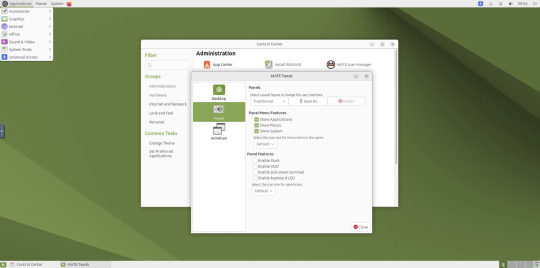
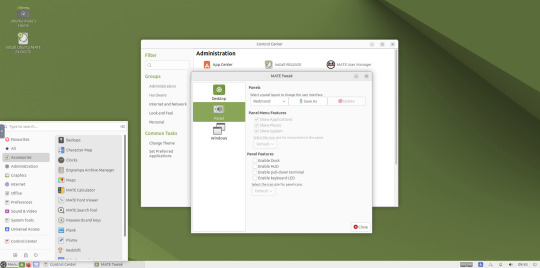
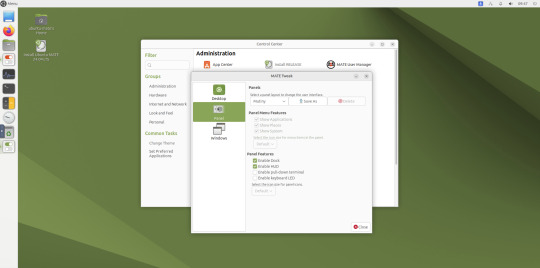
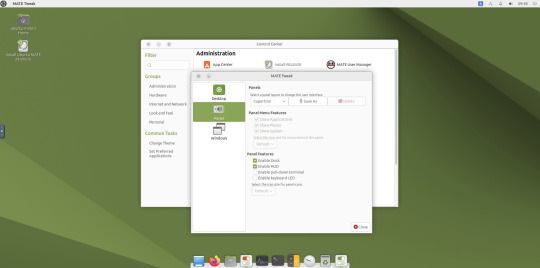
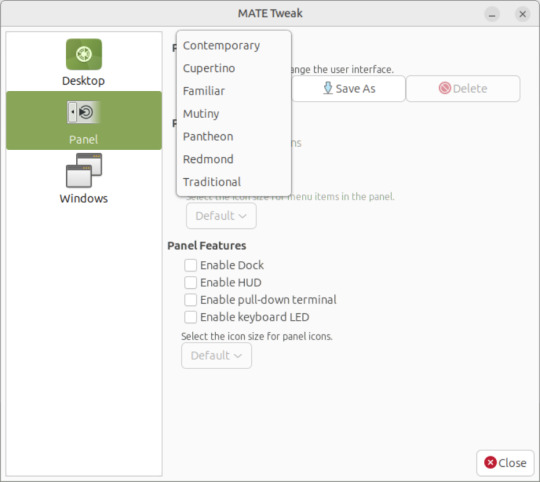
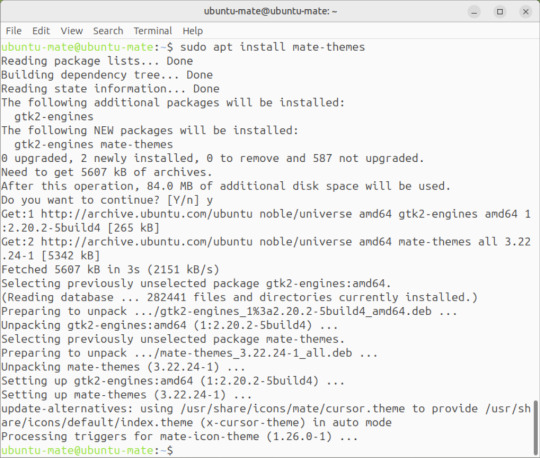

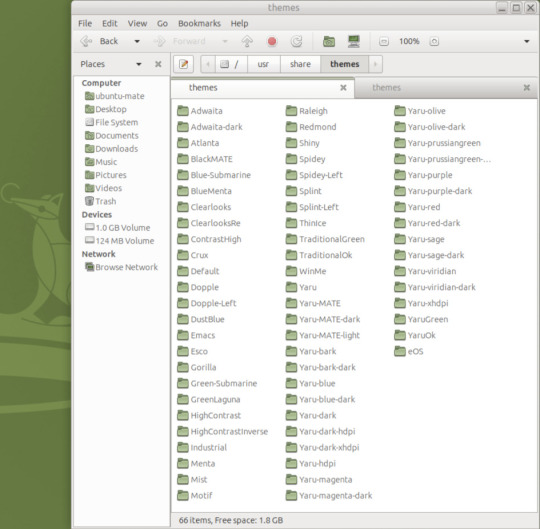
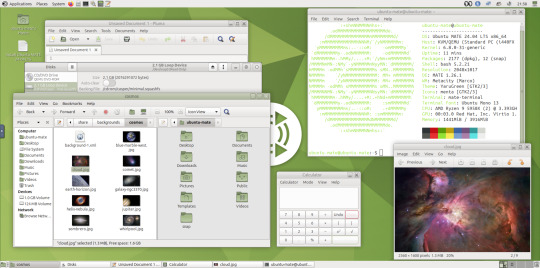
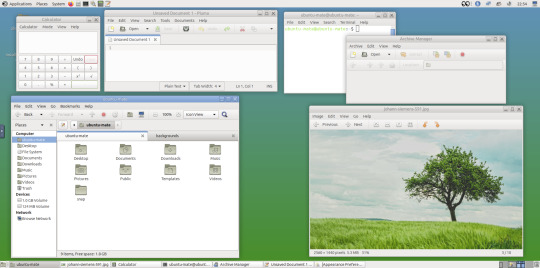
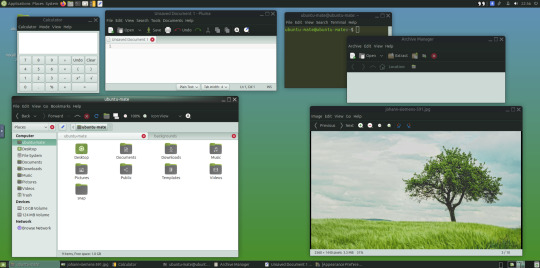
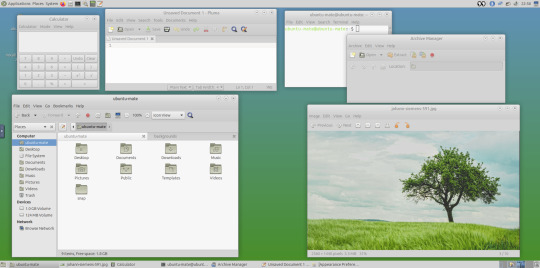
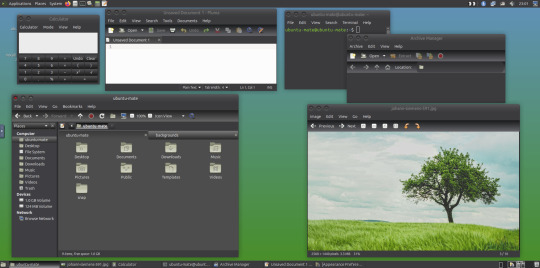

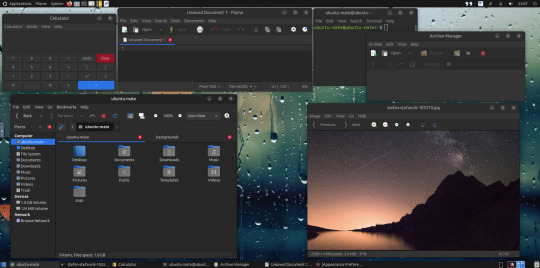

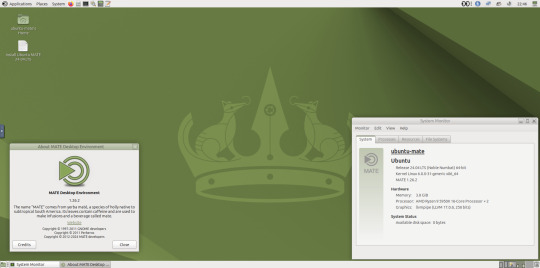

May 2025.
I tried installing a set of themes on Ubuntu MATE 24.04.1 LTS in Distrosea today.
https://distrosea.com/
These themes are provided as a theme package found in vanilla MATE desktops such as Debian and Fedora.
MATE is the modern day continuation of GNOME 2, a very popular, efficient and functional desktop environment from the early 2000s.
The theme pack I selected are compactable GTK3/4 (Graphical Toolkit) versions based on classic GNOME 2 era themes.
Ubuntu MATE website:
https://ubuntu-mate.org/
Debian Linux website:
https://www.debian.org/
Fedora Linux website:
https://fedoraproject.org/spins/mate
See MATE Desktop website here:
https://mate-desktop.org/blog/
About the Graphical Toolkit user interface:
https://en.wikipedia.org/wiki/GTK
I used the MATE Tweak tool to adjust the panels from the 'familiar' layout to the 'traditional' layout. Here are many of the layouts available.
MATE Tweak can change the panel layout between Traditional (GNOME 2), Unity, Redmond (Windows) contemporary (Mac OS) style.
Here are many of the layouts available.
Afterwards, I used the command line to install the themes with the command: sudo apt install mate-themes.
This command then prompted me to agree the system changes and then it installed the required theme files to the list.
I opened up the theme folder in the Caja file manager. This shows all the ones installed on the system.
Next I opened the appearance preferences and cycled through each theme. There are a total of 12 new themes it added alongside the existing Yaru Colour theme collection for Ubuntu.
This package couldn't be installed graphical so this is why I installed it through the terminal. It is also available to install through the Software Manager on Linux Mint.
The theme package can also be installed on the Cinnamon desktop and other linux distributions.
I like these themes as they provide a more 3D feel and is refreshing to see themes for a desktop environment that hasn't moved towards flat design. It themes all the desktop elements from the windows, panels, drop down menus, CSD apps and widgets.
My favourite one is called YaruOK (blue), as it provides resizable window controls, 3D controls and provides a familiar look to the desktop. The theme is also called TraditionalOK.
This theme is a fork of a GTK2 theme called Clear-looks, which was created by Red Hat developers.
YaruOK is a modern variant that uses GTK3 & 4. The theme is rendered in SVG instead of PNG format which improves HiDpi scaling and features themed client side decorations for header bar windows such as the Disks utility.
I also added a GNOME Eyes widget onto the panel!
These fun set of eyes follow your mouse cursor around the screen and can help you find the cursor amongst the clutter of windows. It is built to be very lightweight.
I also like the workspace switcher on the bottom left, which allows you to switch between as many desktop workspaces as you want.
The little square windows within each desktop can be clicked on and moved to another workspace.
Like with other desktop environments, you can also right click a window and move it onto another workspace. Each desktop can be named for a assigned task.
A System Monitor widget can also be added to the panels to display CPU, Memory, Swap and Network processes.
There are many other very interesting widget to play around with on the desktop and panels as well!
Here are the MATE themes in Ubuntu Linux 24.04.1, integrating with the Cinnamon desktop.
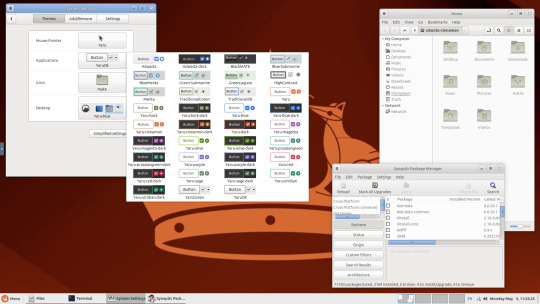
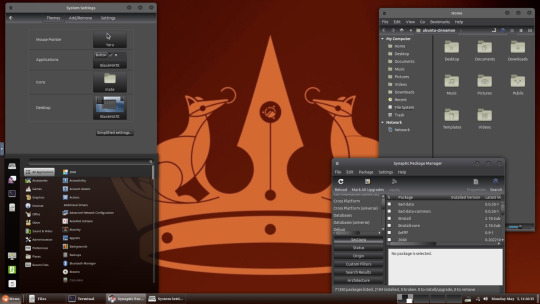
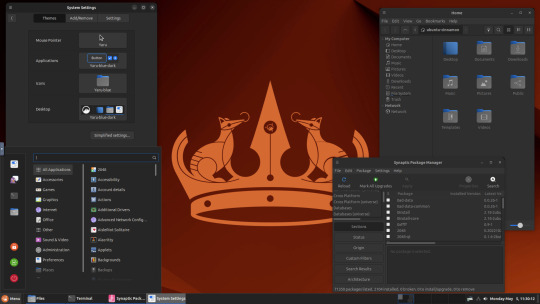
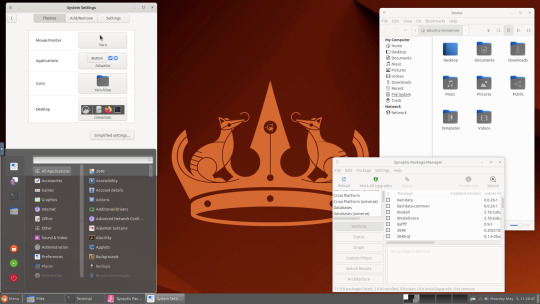
Below are some theming screenshots from Debian MATE 12 Linux.
I've customised the panel, selected the compact menu and changed notification sizes to make it more clearer. The window lists stack onto each other with the increased size.
The MATE panels have adjustable transparency and can be re-coloured and textured very easily through its own preferences box.
See screenshots below!
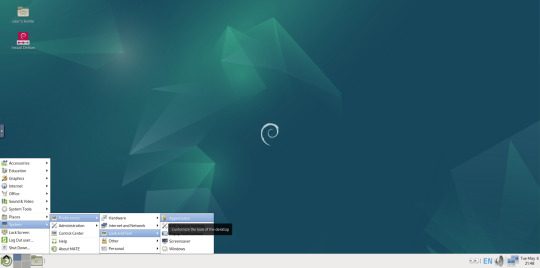
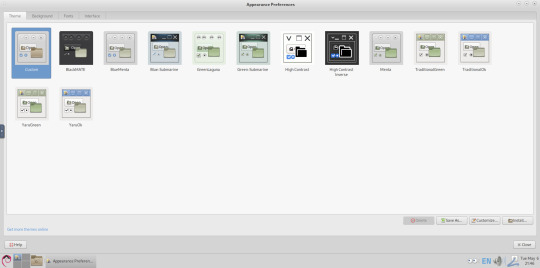
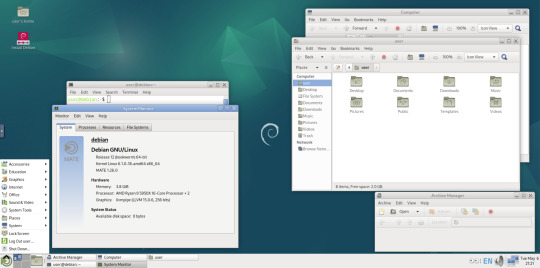
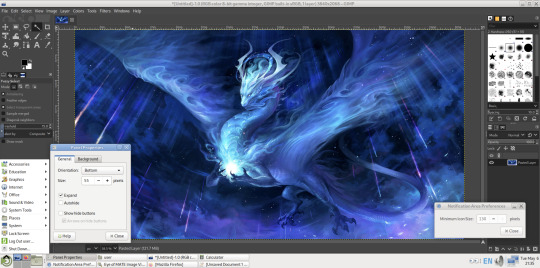
A very interesting look at the user interface elements found in GNOME 2, MATE and Cinnamon Linux desktop environments!
5 notes
·
View notes
Text
My First CTF (Capture the Flag)
I've never had any experience doing CTF's or using nmap, but today has been really fun as I continued to learn how to find flags using nmap. For this to be able to happen, I went on Hack The Box and started practicing on there.
My experience with this was actually quiet fascinating. I learned about port scanning through nmap and have picked up a skill in knowing how to use the Linux terminal and navigate through it. Today, two of my CTF's contained lessons about using nmap to find open ports for Telnet and FTP (File Transfer Protocol). I'll admit it took me a while to learn how to find the flags within those services but I found great enjoyment in it. To be honest, I want to do so much more as I develop these skills and learn how to use new tools. Doing this also has helped me stay off the phone for a bit because doom scrolling on Instagram or YouTube is really unhealthy.
As a beginner in this area, I highly encourage newcomers to get on Hack The Box if you want to learn how to use nmap, as it also gives you a step by step lessons on how to find the flags and teaches you what to look for, for your future use of nmap.
I felt like sharing this post today because I wanted to show the hacking community how excited I am learning these skills, and even though I haven't done as much and an experience hacker, I'm still proud of the work I've done. If there's any advice, or pointers that anyone is willing to give me, I'll gladly take it. Anyways, thank you for reading this post.
And as always, Godspeed everyone.
3 notes
·
View notes
Text
I’m sorry but I’m still losing my fucking MIND over elons incomprehensible Linux own the libs tweet like
Like it’s incredibly obvious he heard about a traceroute, and then googled “how to delete file in Linux” and then didn’t even read the results
Like… woke_mind_virus isn’t a fully qualified domain name, meaning it relies on a custom DNS resolution specific to his machine, or if utilizing a vpn, that specific vpn’s custom host file. Or that the American government would have a host entry for a woke mind virus, which if you’ve ever had to use a government website, is laughable. Also DNS is global for the most part, but honestly we can move on at this point.
So sure, we’ll say that the government has forced all public internet in America to resolve woke_mind_virus. Where does it resolve to? YOUR OWN COMPUTER, you silly billy! Obviously! This is *almost* comprehensible. Sure, we are all infected with the woke mind virus, why not. It must be destroyed within ourselves. Yeah man, whatever. Why not? So how do we destroy it?
Duh! Just delete it! How do we do that in our L337 uber hax0r terminal on our fresh kali live usb (because partitions are scary)? We’ll save that for last.
Because while deleting one file could make a website inoperable, it does not remove every trace of it! It first needs a configuration file in the web server, usually Apache or nginx. This is at LEAST one file, but cmon, if you’re gonna psychologically program the masses and keep it out of public view, you gotta encrypt that shit! So naturally, an SSL is in order! That’s easily 1-3 more files. woke_mind_virus can get a pass on not being fully qualified in this specific case because certs can theoretically be self signed and trusted on local networks, but he wouldn’t be able to tell you that. If you stood up a little one page html site on a web server on your own computer, and navigated to it on port 443 (https://) you would get an SSL error, even though it’s on your own machine. I feel like I’ve beaten this into the ground enough, but just understand it’s stupid.
What’s important to note here is that these BARE MINIMUM files are what routes the request from your machine to the destination site, even if it’s your own computer. If you delete the contents of the site (also called the docroot), the site still exists, and can receive and route requests to and from it, it’s just empty. You’ll probably get a 404 because there’s no actual content to serve. This woke mind princess is in another castle.
It’s also imprudent to delete these configuration files first, because that’s how you determine where the site content actually is! These files dictate what directory (folder for you windows losers) is called upon to actually serve you the content you see displayed when you open a webpage. So you need this information if you don’t want to destroy the entire file system and only want to remove the woke_mind_virus site. Cmon Elon, this is baby shit.
So of course, the strat with the most Efficiency and preserving the rest of the system (which seems to be the point of the tweet) is to find the docroot, delete the docroot, and then delete the web server config files. So how do we delete them?
And here we have it: rm -rf
The syntax is as follows:
rm -rf </path/to/file>
Even if you don’t know shit about Linux, you can probably see the problem here. It’s just so blatantly incorrect, it’s almost as if he’s never done it before.
For those that want to see a real world example, here is me creating a file called woke_mind_virus in my home directory and then trying to delete it the Elon Way:

3 notes
·
View notes
Text
things that i think actually matter for beginner friendliness:
ROBUST FALLBACKS- i think opensuse's default installation is with btrfs root + grub + snapper + snapper hooks so that if an update ever goes bad you have an archive that you can boot from, immediately, straight from the boot screen, no terminal stuff. thats excellent and more distros should offer this oob. vanillaos's abroot system is also really cool with similar benefits
DISCOVERABLE UI- cinnamon (linux mint) is ok with this but i remember trying to figure out desktop and panel (taskbar) configuration was absolutely opaque to me and there weren't easy answers to how you were supposed to do things. i think kde is really excellent in terms of immediately discoverable ui from a windows expat perspective even though i dont really like the mouthfeel of it for personal use
PAINLESS UPDATES- EITHER use a rolling release system or make your default installation use separate root and home partitions, so that when a million dependencies are changed in your point release and you either have to reinstall or upgrade in place and find out everything broke and THEN reinstall, you dont have to frantically go through your entire computer to find where you might have important user files, save them to a usb, and reorganize them on a new install. this one is frustrating because it would be so easy for this to already be a standard for point release distros but it isnt. ??????
the package management thing is like. the whole reason any distros are different. i have my own opinions but it takes all types probably. but if flatpak's repos were better maintained, or if it were more common practice/more friendly and integrated to use distrobox for gui user programs, i think it would make everyones lives easier and level the playing field for people who actually do reasonably need stable* system components but up to date user apps. i think people are being whiny babies when they say its JUST IMPOSSIBLE to remember "apt-get (program name)" instead of pressing a button that says "get program name" but they got guis all over for the people that want them its an overstated problem
THINGS THAT DONT MATTER FOR USER FRIENDLINESS: why does everyone fucking act like ubuntu/mint's point releases and dead and rotting "stable" repos are an absolute benefit to newbies who dont know what they want or how to express what they want yet. breaking and changing dependencies are a bad situation to thrust upon unsuspecting noobs for sure but im pretty sure there is the exact same amount of that regardless of distro because it just does not happen often enough to be dampened by slower releases. like, the appimage integrator they packaged in mint going dead because of aging dependencies. like what did they want me to do about that as the end user who still wanted to integrate appimages?? as far as i could tell the answer is Nothing
*stupid word that causes like 90% of all problems when talking about linux
3 notes
·
View notes
Text
Things I have learned a few weeks after switching to Linux
It's not necessarily a better operating system, in fact it's sort of janky. It's not bad though but, like, I need both my monitor screens up and running and sometimes my second monitor just won't recognize it's been plugged in and to fix this... I have to change the refresh rate. Idk man. There's probably a better solution but this one works and so this one will remain. Even the guy who posted the solution had no theory as to why this worked.
There is a thriving community of people trying to help. They remain somewhat indecipherable to me, but I'm figuring things out.
There are like 9 different ways to get the same result. It's so weird when trying to download things.
Windows did a lot of hand holding. It did a lot of hand holding ohmigod. I spend so much time in this fucking terminal sudo apt ./FuckingPlease
I'm going to have to relearn Reaper (I am one headphone set away from being able to start using it... in earnest. I did a trial run yesterday, it's not as bad as I was afraid it'd be. I just gotta figure out where I put it). Though if some of these changes are due to it running on a different system or if they're due to the several updates I skipped, I may never know...
My hatred for programming has resurfaced with a vengeance. I LEFT YOU IN COLLEGE FOR A REASON.
Sometimes my computer is no longer my computer it is part colleague part indecipherable god. Sometimes I simply do not know what it wants. I am learning to be okay with that.
I went back onto a windows computer for a second and was immediately hit with 3 ads in under 2 minutes and I wasn't even on the internet. I was attacked.
It's nice just having my files on my computer and not fighting the cloud for them. Truly.
Overall after going through hell with the set up, once it's running I just find using my computer to be less overwhelming.
ALSO MY BATTERY LIFE DOUBLED! (maybe quadrupled, it was getting sad I was like off the charger for maybe 3-4 hours and I'd hit 20%, now? I take this sucker off at like 3 and with some use we're at like 40% at 11) Windows?? What were you doing?
2 notes
·
View notes
Text
HOW TO SWITCH TO LINUX
So, we're going to go through this step by step.
Before we begin, let's keep a few things clear:
Linux is not Windows, it is its own system, with its own culture, history and way of doing things.
There are many "distributions", "distros" or "flavors" of Linux. What works for you may be different from what people recommend.
You'll want to read up on how to use the terminal; the basics an absolute beginner needs is short, but important. It's not hard to learn, just takes a bit of time and effort.
ADOBE DOES NOT WORK ON LINUX.
WINE is not a Windows Emulator, it should not be treated as such.
Proton is a compatibility tool built on WINE by Valve, which has its own compatibility database, called ProtonDB. It still isn't an emulator and can have quirks.
Not everything will work on Linux. Dead by Daylight actively blocks Linux players from joining a game, as an example. The Windows Edition of Minecraft is another. (But the Java Edition does!)
There are many FOSS alternatives to popular programs, but they may lack maturity and features compared to their commercial counterparts.
You might want to invest in an external drive. It'll keep your files safe and you'll be able to move all your files to a
Step 1: why do you want to switch? Are you concerned about privacy? Are you wanting to boycott Windows? Is 11 not an option for your hardware? Want to try something new? Be honest with yourself on what you want to do. Write down your hardware specs. You'll want to know what kind of processor, RAM, video card and memory you're working on.
Step 2: Make three lists: Programs you need for work, programs you use at home (that aren't games) and games you like to play. Check each of these for if they already have a Linux port. For games, you can check if it's Steamdeck compatible! For those where you can't find one or it's not clear, you can check for the program on WINE HQ and ProtonDB (for games.) Not all of them might be compatible!
There might be Linux-based alternatives for several things, but keep in mind that Adobe does NOT support Linux and does NOT work on WINE! Sea of Thieves and LibreOffice works, Dead by Daylight and Scrivener do not.
Step 3: Get a GOOD QUALITY USB drive stick! I recommend one that's at least 30 GB. That sounds like a lot, but operating systems these days are huge-but there's some fun stuff you can get. It's really important that you get a good quality one, not just a random stick off a reseller like Wish.
Step 4: Remember when I asked you why you were switching? Time to pick a Linux version. There is no "one, true Linux" version-the operating system is open, groups make their own versions and put it out into the world. If you're confused, check out Distrowatch. Read a list here. Download an option-if you have a few sticks around, try multiple ones.
Step 5: Plug in your USB and use either UNetbootin or Rufus to create your boot device. Rufus might be easier if you're not super computer savvy. When looking over the options, make sure there's some storage, set it to most of what's left. Take out your boot stick for now.
Step 6: Find out how to boot to your BIOS. Every computer has a BIOS. Check out your model of laptop/motherboard to figure out what it is. Arrange boot order so that your USB gets checked first.
Step 7: If you have an external drive, move all your personal stuff, game saves, etc to it or purchase cloud drive storage for it. Always back up your files, and with multiple methods.
Step 8: You aren't going to be installing Linux quite yet; instead, boot it up from USB. Note, it'll be a bit slow on USB 2.0, though a USB-3 device and slot should make matters easier. Test each version you're considering for a week. It is super important that you test! Sometimes problems crop up or you turn out to not like it!
Step 9: Once you find a distro you like and have tested, consider if you want to dual boot or completely wipe Windows. Some programs for work might require Windows or you might have a few games that ONLY work on Windows and that's perfectly fine! Just keep in mind, as of Windows 11, this option is not recommended. If you want to use dualboot, you want to keep Windows 10 and NOT update. There's great tutorials on how to make it happen, search engines should be able to point you to one.
Step 10: Fully install Linux and immediately update. Even the latest installers will not have the current security patches. Just let it update and install whatever programs you want to use.
Step 11: Enable compatibility tools in Steam if you're a gamer. File, options, compatibility. Also, check the Software Store in your OS for open source re-implementations for your favorite older games!
You're now a Penguin!
23 notes
·
View notes
Text
How to install the native gog(and maybe steam? I dont own it to check) linux version of Star of Providence (monolith: relics of the past)! a very niche tutorial for maybe 6 people in the world.
This also might slightly help as a base guide in learning how to troubleshoot programs and games on linux.
This guide assumes you have Steam installed and can be trusted to find certain library files if you do not already have them installed. On my personal system I am running openSUSE tumbleweed and will be using Lutris to launch the game, but equivalent steps for launching through Steam will be provided when needed.
Firstly, turn off hidden files.
the base game is 32-bit only and requires files from /.steam/bin/steam-runtime/lib/1386-linux-gnu Base game+DLC is 64-bit only and requires files from /.steam/bin/steam-runtime/lib/x86-64-linux-gnu
if you're using Lutris. inside your monolith game directory place a new folder named "lib" place "libcrypto.so.1.0.0" and "libssl.so.1.0.0" from your respective steam-runtime/lib folders into the monolith lib directory in lutris, right click and confiure on monolith, select toggle "advanced" on the top right of the window under game options "add directory to LD_LIBRARY_PATH" add your lib directory in the monolith folder
on Steam.
into your game properties tab paste either
for base game
LD_PRELOAD="~/.steam/bin/steam-runtime/lib/1386-linux-gnu/libssl.so.1.0.0 ~/.steam/bin/steam-runtime/lib/1386-linux-gnu/libcrypto.so.1.0.0" %command%
OR
for base + DLC
LD_PRELOAD="~/.steam/bin/steam-runtime/lib/x86_64-linux-gnu/libssl.so.1.0.0 ~/.steam/bin/steam-runtime/lib/x86_64-linux-gnu/libcrypto.so.1.0.0" %command%
for the base game we should be done and the game is playable however, with the DLC at this point we're still missing (on opensuse tumbleweed, your system might be different, check your games logs while trying to launch)one library file to make the game launch, it wants to look for libcurl-gnutls.so.4 which is unavailable in the repos of non ubuntu/debian based distros, however this file (seems to be) completely cross compatible with libcurl.so.4 so we're going to be making a symbolic link, so when the game searches for libcurl-gnutls.so.4 it will find libcurl.so.4
open a terminal in your system's /lib64/ folder, with Dolphin this can be done by right clicking an empty space and under actions select "open terminal here", alternatively just move to the directory inside of your terminal paste | sudo ln -s libcurl.so.4 libcurl-gnutls.so.4
(now, this might have negative consequences however, I do not know what they would be and someone who actually codes might be able to pitch in here. if so, just add it to the lib directory for the game for lutris or add a new folder under LD_PRELOAD on the steam properties) the game should now be playable
Alternatively to all of this, just use proton. on Steam just change the compatibility mode to the latest version and in Lutris install the base games windows version and run it using proton or wine-ge, to get the dlc to work select "Run EXE inside Wine prefix, this can be found to the right of the play button at the bottom of the list to the right of the wine button. Now launch the DLC installer. Congrats! You got the game to work in hopefully a quarter of the time it took me to both figure this out and document all of this!
3 notes
·
View notes
Text
Linux/Fedora and Sims 2....
SO, as I had mentioned before, I had planned to put linux on an old potato laptop I had laying around that doesn't get used. My bestfriend came over about a week or so ago and helped me with putting Ubuntu, Lutris and wine on the laptop. I was super stoked to get started playing the Sims 2 without pink or crashing.. I folllowed Osab's installation guide for linux off of github and when I finished, I launched the game and....nothing. I tried a few different things with no luck so I cried to my bestfriend about it and he got me to get teamviewer and did some stuff in the terminal and read the logs for the game to see what was going on. Turns out there was a missing dll file and then that lead to finding out that there was a conflict with Wine and Lutris.. he had to go so he kinda told me what to do, i asked in some of the sims discord servers if anyone had experience with playing sims on linux, someone responded and helped me a bit.. she was super nice and said if i had any questions, to ask her which I completely appreciate. I got to thinking, maybe I should just bite the bullet and install fedora 41 onto an ssd I have in my computer that I don't generally use that much except for storing some editing stuff that I was doing for a youtuber friend.. I cleared it out, followed a video tutorial on how to do it. When I tried to boot Fedora onto my ssd to test it out(not install it) an error came up and it wouldn't load.. I didn't want to fuck with it incase I did something to screw with my Windows stuff so I left it. I told my bestfriend about it the next day and he said to do something about the usb and I told him I was done messing around with it because it was giving me anxiety and I literally just want to play my game. SO, this morning I called a PC place and asked if they were able to do Linux installs as a partition and they said they could but they don't install programs or anything like that, which is fine with me cause I know how to install the other two programs that I need... he said that he will do it and will teach me how to unplug my main ssd that has windows on it so no corruption ensues, I'm sure it may be a little overkill but if it protects all my stuff on my windows drive, I'll do it, lol. I take it on Friday morning and hopefully will get it back by the afternoon. it's going to cost me like 85$ or so to do it but I rather a professional handle it and not have to worry about screwing it up. SO hopefully I'll have Sims 2 running on my pc by next week and I couldn't be more excited. Here's to hoping I can finally play, I'm getting desperate LOL.
4 notes
·
View notes
Text
Last Monday of the Week 2024-12-16
Entering the Holiday Vortex any day now
Listening: The soundtrack to Cats: The Musical because I have never stopped being a musicals nerd. Prompted me multiple times to check if they got rid of a fun part from a song in the 2019 movie and they always did! Got rid of Deuteronomy's 99 wives, entirely dropped The Moments of Happiness, and in order to resolve that, here's The Moments of Happiness.
youtube
One of those bizzare meandering songs.
Watching: Watched Get Out because I figure I should get the Peeleverse going.
It's good! It does a great job of making you deny the very obvious fact that the girlfriend is extremely in on it the whole time until you can't anymore and it's like, yes, of course, she is not somehow being manipulated or brainwashed she's just as into this as the rest of them, it's very smooth.
Love how every single person talks like an evil vizier.
Reading: Started The Parable of the Sower. Look there's not much to say that hasn't already been said, Butler is a good author, I only just started but it's interesting to read this like, half imagined half lived reference to what it feels like to be surrounded by abject poverty. It's bad! It's not a fun experience, and I think this is a really good coverage of how it feels to be in this environment and how it affects the way you think about people.
It stands out to me that one of the big themes being set up here is the protective and isolating force of walls, which. If you are ever in South Africa you will notice immediately the shockingly large number of walls. Every single house has walls, and the richer an area is the higher the walls are, in Soweto every little house has a meter and a half high brick wall, my suburbs had two meter walls, Sandton has three meter walls, topped over with electric fences. This is probably not an experience you have had. Going to other places and finding that they just. don't have walls. It's very strange.
Still getting going! Going to be interesting!
Playing: More! Cyberpunk. The city design is crazy, it's so heavily layered in many places. They do funnel you into a few more heavily designed zones so you don't notice the emptier areas as much but the designed areas are SO huge. Layer upon layer of detail and flash and colour. It makes Skyrim and GTA V look like sandpits.
Hit level 20 netrunning the other day and it's extremely fun to hit people with the ten thousand beam attack the second they pop their head up. You really have to lean on your abilities and cyberware if you want to survive which is nice, very much aligned with the game. I am pleased to notice that the DLC includes a copy of the CP2020 rules which I have been rereading. Friday Night Firefight is such a good read.
Making: 3D printed skull! RobotOS stuff! Lots of middleware stuff that doesn't lead to much.
Tools and Equipment: I keep saying I'm gonna talk about Distrobox. Let's talk about Distrobox.
Distrobox is a container management tool that goes basically the opposite way to every other container system, and aims to tightly integrate the containers it runs with your desktop system. Containers run in distrobox inherit your home directory, access to most peripherals and hardware, tie in to your display manager, and as much as possible try to act like they're meant to be part of your base system.
It can use podman, docker, or the bizzare ultra-lightweight userspace-only container manager lillipod to host containers, which means that in that last case you can run it on any system even if you don't have root, I've done this on my work dev server at $oldjob before we got Podman on there.
This means that, for instance, you can directly access your files from the container without having to mess with complex shared mounts or copying files back and forth, and it allows GUI applications launched within a distrobox to just appear on your desktop as though they were native.
This allows you to mix and match packages and features from a variety of different systems very easily, and is particularly handy for developing for multiple distributions or using tools that only really ship for one distro. At work I had to run mksusecd to build some install images and rather than deal with trying to set up mksusecd on Ubuntu, I just dropped into a SUSE Tumbleweed distrobox and got to work. Worked great!
I've also used it to sandbox messy development environments and I'm currently using it to host a robotOS learning playground on my desktop without having to look after an run a whole VM or anything. It means that the install of neovim and zsh and whatever in the Ubuntu container directly inherit my standard config files and even have access to the same plugin ecosystem as on my base system!
You can heavily customise your distroboxes, allocating them separate homedirs if necessary, exporting apps from inside a distrobox to the host system so you can seamlessly run them as though they're installed on the host, and more weird designs. Really handy tool!
Here's some reading if you're interested
Containers are really cool.
5 notes
·
View notes
Text
Customized system again!!
You might be surprised to find out this is Mac OS. I love Linux so much but it just does not work well on my m1 Mac, so customization is relatively minimal. I tried my best to replicate my other computers Linux rice which was Void-I3wm-Polybar, but I think this honestly looks better than anything I ever did with that. All software used to do this are open source!
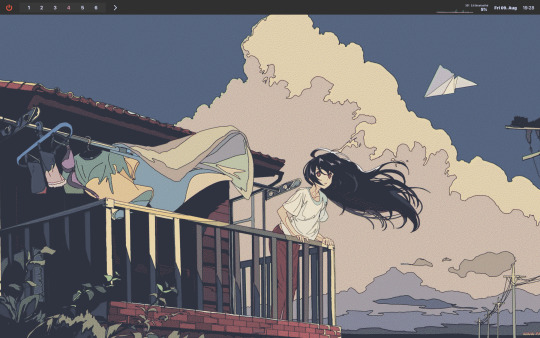
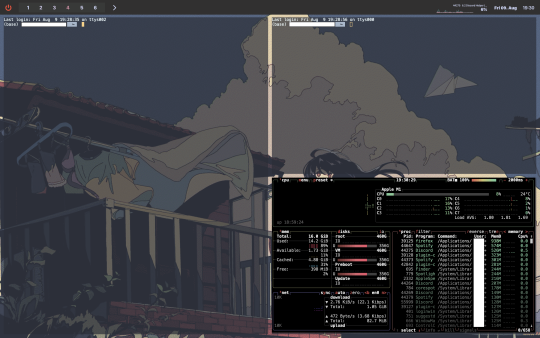
Top Bar: Sketchybar Window Manager: Yabai Operating System: Mac OS Color Scheme: Gruvbox Wallpaper: Gruvbox Wallpaper Terminal: Alacritty I'll post the dot files if enough people ask.
#linux#open source#void#void linux#macos#mac#macbook#customization#i3wm#polybar#nerd#rice#linux rice#macos rice#yabai#gruvbox#alacritty#sketchybar#theming#computer#computers#computer theming#desktop#desktop theming#software
4 notes
·
View notes